Cabeceras Aid Project
Spring 2006 Update

Dear Friends,
It is our pleasure to bring you up-to-date on the work Cabeceras Aid Project has done since we wrote our last update in the spring of 2005, and to let you know what 2006 holds for our organization.
In 2005, Cabeceras continued several long-term field projects, as well as seeing the completion of a few others (details below). Our two principal fieldworkers, Lev Michael and Chris Beier, were in Peru from January through August; their extended stay was made possible by their doctoral dissertation research projects based in Montetoni. While in the Amazon Basin, they carried out several field projects for Cabeceras, and strengthened our organization's political network, which will greatly aid Cabeceras' effectiveness in ongoing and future projects in collaboration with small indigenous communities in Peruvian Amazonia.
Elections of Cabeceras' Board of Directors
As a 501(c)(3) organization, Cabeceras Aid Project is governed by a board of ten individuals who make important decisions regarding the actions our organization will take, in order to best fulfill its stated goals. Cabeceras' board members bring professional expertise, personal experience, and deep commitment to our organization, providing a solid foundation upon which our field projects are built. Their service is indispensable, and Cabeceras thanks these individuals for everything they give to our organization.
In January 2006, eight of Cabeceras' ten board members' three-year terms expired. At our annual board meeting on January 21, 2006, the existing board voted in new board members and officers. The following founding board members were re-elected for another three-year term: Chris Beier, Carol Fox, Lev Michael, Margo Minogue Heyl, and Roahn Wynar. In addition, we welcome three new board members: Cynthia Anderson, Joel Dippold, and Linda Young. The ongoing terms of directors Robin Gerrow and Anthony Woodbury expire in January 2007 and January 2008, respectively.
The board also voted in the following officers: Lev Michael, President; Robin Gerrow, Vice President; and Chris Beier, Secretary and Treasurer.
Short profiles of our board members are available at: www.cabeceras.org/board.htm
Camisea Nanti Project
2005 was another important year in the relationship between Cabeceras and the Nanti communities on the upper Camisea River. From February to May, Chris and Lev again lived in Montetoni, primarily working on their doctoral dissertation research. We are happy to report that overall, the communities are in excellent health, both physically and socially. As a result of our numerous extended stays over the last few years, we have considerably deepened our understanding of Nantis' priorities and concerns regarding their own social and political future, which makes us more effective allies in promoting Nantis' self-determination and well-being in the future.
The area in which Nanti self-determination is presently being challenged is the area of formal education. In 2005, the Dominican mission based in Kirigueti continued its initiative to establish a school in Montetoni. Most Nantis are ambivalent about the value of a school, and many adults worry about the social consequences of the continued presence of outsiders, especially male schoolteachers. In the 1990s, a schoolteacher living among the Nantis exploited them economically and showed tremendous disrespect for Nanti ways, and Nantis are worried that this may happen again.
We feel it is crucial that any school established by outsiders in Montetoni respect Nantis' priorities and way of life. Therefore, we are currently working with AIDESEP, the major indigenous federation for Peruvian Amazonian peoples, to develop a culturally and politically appropriate education plan for the Nanti communities. Using our knowledge of Nanti culture and language, we hope to develop a plan that will meet Nantis' long-term needs to obtain useful knowledge from the outside world (like writing), without causing social and political turmoil.
In addition, in February we provided basic medical supplies to the health promoters in Montetoni and Maranksehari, as part of Cabeceras' ongoing commitment to the Nanti communities.
Urubamba River Valley Medical Aid Project
In February 2005, Chris and Lev once again delivered basic medical supplies to the Matsigenka communities of Nueva Luz, Kirigueti, Camisea, Segakiato, and Cashiriari. For several years, Cabeceras has provided supplies to these healthposts to serve individuals living in or near these communities, who otherwise would have no access to cost-free medicines. As before, these supplies were gratefully received, and we look forward to making another delivery of basic medical kits in April 2006.
The purpose of the Urubamba River Valley Medical Aid Project is to help meet the medical needs of Matsi-genka, Asháninka, and Kakinte communities until the PeruvianMinistry of Health is able to bring larger quantities of medicines into the region for its hospitals, healthposts, and community health promoters. In the interim, Cabeceras is responding to requests from medical personnel stationed in the region to ensure that communities do not have to do without basic but essential life-saving medical supplies.
Purús River Research Project
In the fall of 2004, Cabeceras fieldworker Catherine Clark visited the upper Purús River region, one of the most remote areas of Peruvian Amazonia. Catherine's goal was to update our information regarding the Mashco Piros and the Mastanahuas, two indigenous groups living in voluntary isolation in the region, focusing on threats to their well-being and self-determination.
In 1999, Cabeceras had published a report on these same issues, which alerted indigenous federations and other NGOs to the threats faced by these groups, and which played a role in the creation of a protected area for them. Catherine's research determined that despite these efforts, there has been a tremendous escalation of illegal logging in the territories of these groups, and that drug traffickers have begun to use this remote region as a route to nearby Brazil. In addition, evangelical missionaries have continued efforts to make forced contact with these groups in order to convert them.
In March 2005, Catherine, Chris, and Lev completed a lengthy co-authored report on Catherine's research. Cabeceras' report has already been cited, in Brackelaire's diagnostic on isolated indigenous peoples in Latin America, released in January 2006. We hope that our report will aid AIDESEP and other organizations in addressing the serious threats to the well-being of these indigenous peoples.
Pakiria Matsigenka Project
In May 2005, within hours of arriving in the frontier town Sepahua, Lev and Chris began to hear stories that the Dominican mission had found three "naked, uncontacted natives" on a beach, and had brought them to Sepahua to live. According to these stories, the two elderly women and one young man "were tired of living in the forest" and "wanted to resettle their families at the mission in Sepahua." Skeptical of these stories, we decided to find out more about the situation. Once we located the three newcomers, we quickly determined that they were Matsigenkas who lived on the upper Pakiria River. Conversing with them in Matsigenka, we learned that, in fact, they were not happy in Sepahua and were very anxious to return to their homes, families, and gardens.
Because of the many contradictions between the Matsigenkas' and Dominicans' perspectives that emerged during the interviews we carried out, we decided to write a report on the situation, which we then presented to AIDESEP. Similarly concerned about the Pakiria Matsigenkas' welfare and freedom, AIDESEP launched an investigation - which quickly prompted the mission to return the three Matsigenkas to the beach where they'd found them.
Matsigenka Oral History Project
In 2003, a Matsigenka school teacher named Lucio Abral Turco approached Lev and Chris and requested that Cabeceras support him in carrying out a small research project to record oral histories of the Matsi-genka community of Cashiriari. Lucio's motivation was two-fold: to create an oral history archive for the community; and to use these records to write a history of the community in order to complete his own professionalization program as a bilingual teacher.
In 2003, Cabeceras provided Lucio with a small research grant; and in 2004, Lucio completed his research in Cashiriari. We are pleased to report that in 2005, Lucio finished his thesis and received his certi-fication as a bilingual teacher. These credentials will help him continue his teaching career, through which he will be able to provide culturally-sensitive and his-torically-informed education to Matsigenka children.
Omagua Documentation Project
Omagua was once the most widely spoken language in the Amazon Basin, with as many as 1.5 million speakers. Unfortunately, because the Omaguas lived on the main Amazon River, they suffered especially heavily from the Spanish and Portuguese conquest and its brutal legacy. Today, Omagua is virtually extinct, spoken by fewer than 10 people, all in their 70s. Cabeceras has ascertained that without immediate action, this once vibrant language will disappear with almost no historical or linguistic documentation of its existence.
In fall 2003, Cabeceras fieldworker Catherine Clark carried out a pilot study of the Omagua language, in San Joaquin de Omaguas, in northern Peruvian Amazonia. As a result of Catherine's initial visit, in 2004 Cabeceras sent linguist Edinson Huamancayo to San Joaquin, where he carried out 7 weeks of intensive linguistic documentation of Omagua. Edinson's work is the first descriptive work on Omagua since the 18th century, when it served as a lingua franca along the main Amazon River.
As a result of Edinson's linguistic work, Cabeceras began to work directly with Arnaldo Huanaquiri, the only literate Omagua speaker in San Joaquin. Arnaldo has an amazing gift and passion for documenting his first language and culture. In 2004 and early 2005, Cabeceras funded Arnaldo to produced notebook after notebook of stories and historical information in Omagua. Arnaldo speaks of this work as his best opportunity to create permanent records and resources for future generations of his people. In 2006, we hope to continue our work with Arnaldo and on Omagua, ideally commissioning a study of the basic sound system of the language which will complement Arnaldo's extensive writings.
Iquito Language Documentation Project (ILDP)
From June to August 2005, Lev and Chris returned to the Iquito community of San Antonio, on the Pintuyacu River in northern Peruvian Amazonia, to continue the ILDP, a multi-year project to document and revitalize the Iquito language. They directed a team of seven linguists - the largest team yet - in-cluding two community linguists (Hilter Panduro and Marcelo Sinchija), two licenciatura students from the Universidad Nacional Mayor de San Marcos in Lima (Sisi Bautista and Karina Sullón), and three graduate students from the University of Texas at Austin (I-wen Lai, Brianna Rauschuber, and Molly Harnisch). This team worked closely with fluent Iquito speakers, continuing the process of creating a dictionary, a grammar, and both audio and written archives of Iquito historical, mythical, and personal narratives.
With only about 25 remaining elderly speakers, Iquito is a highly endangered language. In recent years, however, the Iquito community has been anxious to develop teaching materials and programs so that children will learn some of the language. Cabeceras launched the ILDP in 2001 in response to the community's concerns.
The majority of the funding for the ILDP is now provided by the Hans Rausing Endangered Languages Programme (www.hrelp.org). However, the initial phases and the major infrastructure of the project were funded by Cabeceras in 2002, and Cabeceras now provides supplementary funding to meet community requests that fall outside the scope of the HRELP grant. The ILDP will be completed in December 2006.
Overview of 2006
In April 2006, Chris and Lev will return to Peru for another nine months of fieldwork on various projects. First, in late April and early May, they will make a brief visit to the Camisea Nanti communities, in order to deliver medical and material aid and to observe the current situation regarding formal education. Then, from mid May through mid December they will carry out the final phase of the Iquito Language Documentation Project - which will include the participation of linguist and new Cabeceras board member Cynthia Anderson. Finally, from late December through early January 2007, they will make an exploratory trip, visiting several indigenous communities in the northern Peruvian Amazon Basin, in order to scout out the best site for Cabeceras' next large-scale language revitalization project.
Organizational Administration
Again in 2006, board member Robin Gerrow will act as deputy secretary and treasurer while Chris Beier is in Peru. Cabeceras' principal office is presently located at Robin's home. Thank you, Robin (and family members Tom and Nathan), for all that you have taken on to keep Cabeceras running smoothly!
Financial Support
Cabeceras Aid Project continues to rely on small contributions from individuals and organizations to fund the majority of our field projects. We thank you for your continuing financial support! If you earmark your gift for a specific field project, 100% of your donation will be used for that project. We welcome your financial support, via check, sent to:
Cabeceras Aid Project, 1303 Karen Avenue, Austin TX 78757-3017
Or online via credit card at:
Cabeceras Aid Project is a 501(c)(3) non-profit organization, so your gift to us is tax deductible. Our Tax ID number is: 74-2799387
THE END
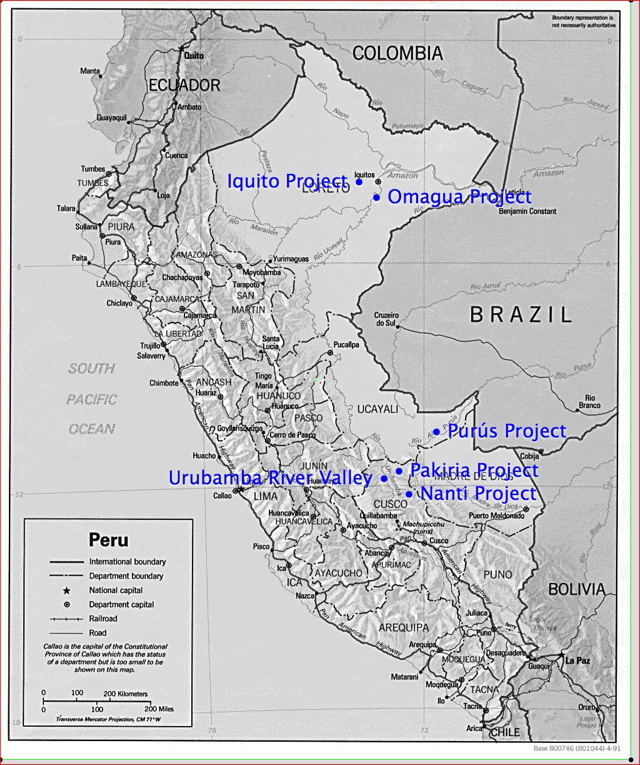
The locations of Cabeceras' projects in 2005
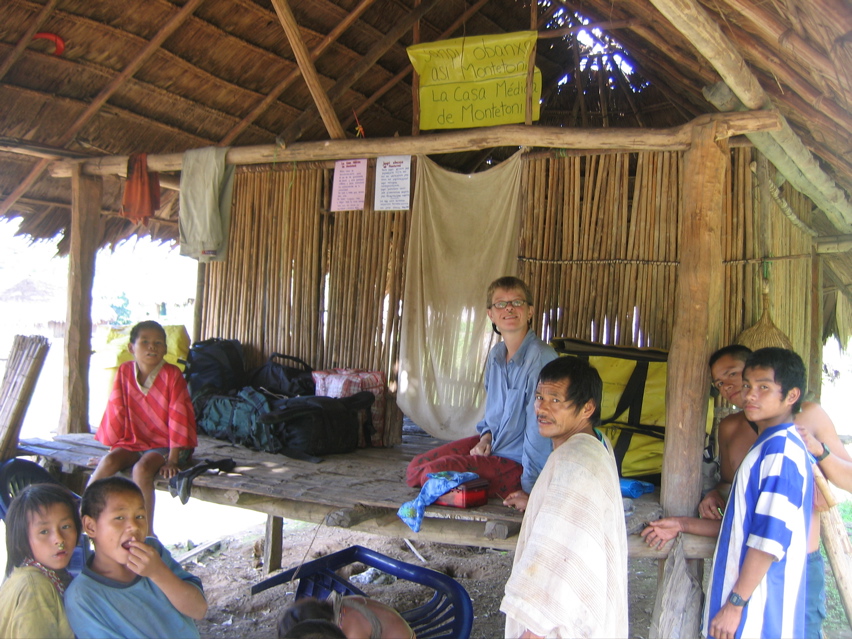
When Lev and Chris left Montetoni in May 2005, their hut became a medical post Ð or, as the sign above the door says, 'janpi obanxo.'
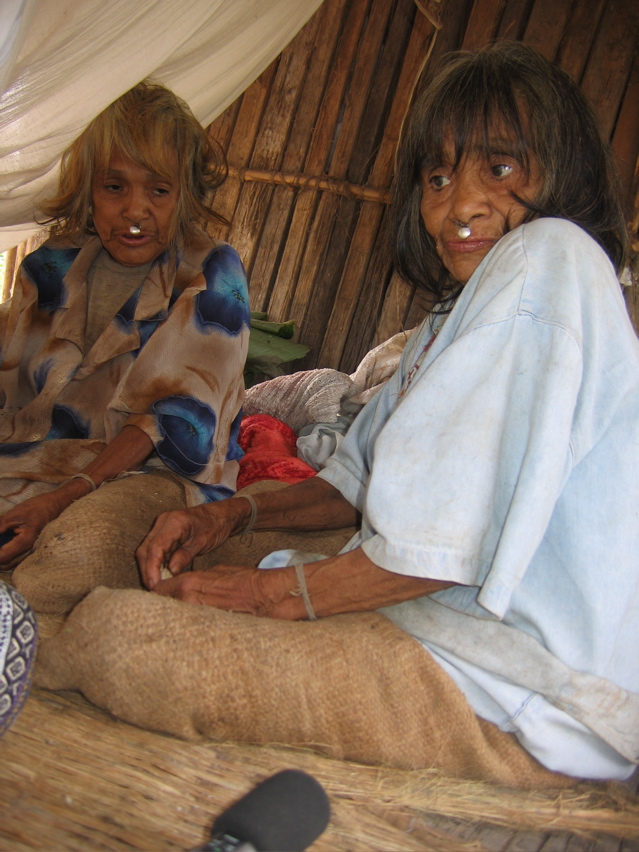
Two Pakiria Matsigenka women in Sepahua, waiting to go home.
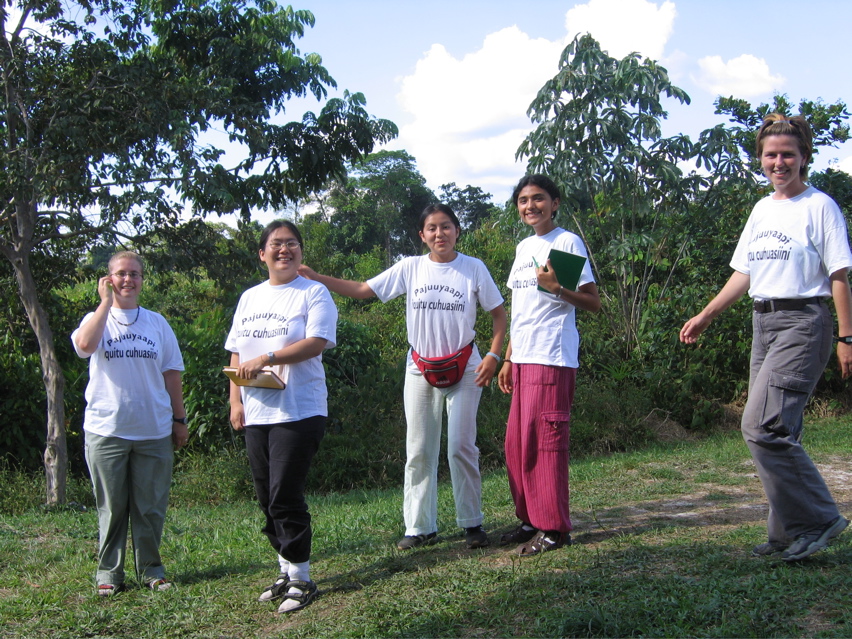
Brianna, I-wen, Sisi, Karina, and Molly perform a skit in Iquito, during the 'Iquito Speakers Day' celebration in San Antonio, July 2005
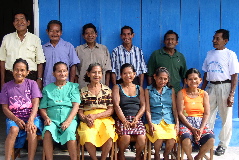
Twelve of the remaining speakers of Iquito at a community celebration in their honor in 2004